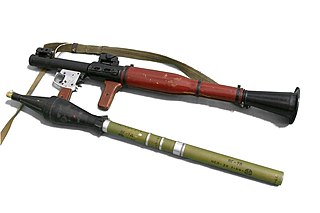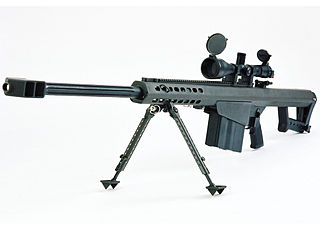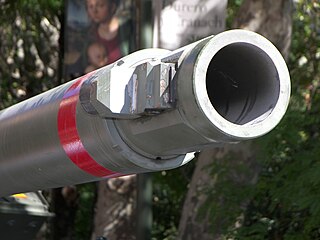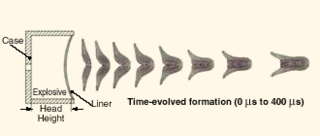Related Research Articles

The Defense Advanced Research Projects Agency (DARPA) is a research and development agency of the United States Department of Defense responsible for the development of emerging technologies for use by the military.

A rocket-propelled grenade (RPG) is a shoulder-fired missile weapon that launches rockets equipped with an explosive warhead. Most RPGs can be carried by an individual soldier, and are frequently used as anti-tank weapons. These warheads are affixed to a rocket motor which propels the RPG towards the target and they are stabilized in flight with fins. Some types of RPG are reloadable with new rocket-propelled grenades, while others are single-use. RPGs are generally loaded from the front.

A shaped charge is an explosive charge shaped to focus the effect of the explosive's energy. Different types of shaped charges are used for various purposes such as cutting and forming metal, initiating nuclear weapons, penetrating armor, or perforating wells in the oil and gas industry.

The M198 is a medium-sized, towed 155 mm artillery piece, developed for service with the United States Army and Marine Corps. It was commissioned to be a replacement for the World War II-era M114 155 mm howitzer. It was designed and prototyped at the Rock Island Arsenal in 1969 with firing tests beginning in 1970 and went into full production there in 1978. It entered service in 1979 and since then 1,600 units have been produced.

Reactive armour is a type of vehicle armour, typically used to protect modern tanks against shaped charges and hardened kinetic energy penetrators. The most common type is explosive reactive armour (ERA), but variants include self-limiting explosive reactive armour (SLERA), non-energetic reactive armour (NERA), non-explosive reactive armour (NxRA), and electric armour. NERA and NxRA modules can withstand multiple hits, unlike ERA and SLERA.

The .50 Browning Machine Gun, also known as the .50 BMG, 12.7×99mm NATO, and designated as the 50 Browning by the C.I.P., is a .50 in (12.7 mm) caliber cartridge developed for the M2 Browning heavy machine gun in the late 1910s, entering official service in 1921. Under STANAG 4383, it is a standard service cartridge for NATO forces, as well as many non-NATO countries. The cartridge itself has been made in many variants: multiple generations of regular ball, tracer, armor-piercing (AP), incendiary, and saboted sub-caliber rounds. The rounds intended for machine guns are made into a continuous belt using metallic links.

High-explosive anti-tank (HEAT) is the effect of a shaped charge explosive that uses the Munroe effect to penetrate heavy armor. The warhead functions by having an explosive charge collapse a metal liner inside the warhead into a high-velocity shaped charge jet; this is capable of penetrating armor steel to a depth of seven or more times the diameter of the charge. The shaped charge jet armor penetration effect is purely kinetic in nature; the round has no explosive or incendiary effect on the armor.

Plunging fire is a form of indirect fire, where gunfire is fired at a trajectory to make it fall on its target from above. It is normal at the high trajectories used to attain long range, and can be used deliberately to attack a target not susceptible to direct or grazing fire due to not being in direct line of sight.

An anti-materiel rifle (AMR) is a rifle designed for use against military equipment, structures, and other hardware (materiel) targets. Anti-materiel rifles are chambered in significantly larger calibers than conventional rifles and are employed to eliminate equipment such as engines and unarmored or lightly armored targets. While modern armored vehicles are resistant to anti-materiel rifles, the extended range and penetration still has many modern applications. While not intended for use against human targets, the bullet weight and velocity of anti-materiel rifles gives them exceptional long-range capability even when compared with designated sniper rifles. Anti-materiel rifles are made in both bolt-action as well as semi-automatic designs.

The Carl Gustaf 8.4 cm recoilless rifle is a Swedish developed 84 mm (3.3 in) caliber man-portable shoulder-fired recoilless rifle, initially developed by the Royal Swedish Army Materiel Administration during the second half of the 1940s as a close-range anti-tank and support weapon for infantry, which has seen great export success around the globe and is today a popular multi-purpose support weapon in use by many nations. The Carl Gustaf 84 mm recoilless rifle is a lightweight, low-cost weapon that uses a wide range of ammunition, which makes it extremely flexible and suitable for a wide variety of roles.
Rolled homogeneous armour (RHA) is a type of vehicle armour made of a single steel composition hot-rolled to improve its material characteristics, as opposed to layered or cemented armour. Its first common application was in tanks. After World War II, it began to fall out of use on main battle tanks and other armoured fighting vehicles intended to see front-line combat as new anti-tank weapon technologies were developed which were capable of relatively easily penetrating rolled homogeneous armour plating even of significant thickness.

Military vehicles are commonly armoured to withstand the impact of shrapnel, bullets, shells, rockets, and missiles, protecting the personnel inside from enemy fire. Such vehicles include armoured fighting vehicles like tanks, aircraft, and ships.

The CBU-97 Sensor Fuzed Weapon is a United States Air Force 1,000-pound (450 kg)-class freefall Cluster Bomb Unit. It was developed and produced by Textron Defense Systems. A CBU-97 used in conjunction with the Wind Corrected Munitions Dispenser guidance tail kit is converted to a precision-guided weapon, and the combination is designated CBU-105.
The Yasin, also known as Yassin, or Al-Yassin, is an anti-tank weapon developed by Hamas, first deployed in 2004. It was named after Hamas' spiritual leader, Sheik Ahmed Yasin, killed by the Israeli Defense Forces, or IDF, on March 22, 2004.

The Rheinmetall Rh-120 is a 120 mm smoothbore tank gun designed and produced in former West Germany by the Rheinmetall-DeTec AG company, it was developed in response to Soviet advances in armour technology and development of new armoured threats. Production began in 1974, with the first version of the gun, known as the L/44 as it was 44 calibres long, used on the German Leopard 2 tank and soon produced under license for the American M1A1 Abrams and other tanks. The 120-millimetre (4.7 in) gun has a length of 5.28 metres (17.3 ft), and the gun system weighs approximately 3,317 kilograms (7,313 lb).

The FGM-172 SRAW, also known as the Predator SRAW, was a lightweight, close range missile system produced by Lockheed Martin, developed by Lockheed Martin and Israel Military Industries. It is designed to complement the FGM-148 Javelin anti-tank missile. The Predator had a longer range and was more powerful than the AT4 that it was designed to replace, but had a shorter range than the Javelin.

An explosively formed penetrator (EFP), also known as an explosively formed projectile, a self-forging warhead, or a self-forging fragment, is a special type of shaped charge designed to penetrate armor effectively, from a much greater standoff range than standard shaped charges, which are more limited by standoff distance. As the name suggests, the effect of the explosive charge is to deform a metal plate into a slug or rod shape and accelerate it toward a target. They were first developed as oil well perforators by American oil companies in the 1930s, and were deployed as weapons in World War II.

Ammunition is the material fired, scattered, dropped, or detonated from any weapon or weapon system. Ammunition is both expendable weapons and the component parts of other weapons that create the effect on a target.

A precision-guided munition is a guided munition intended to precisely hit a specific target, to minimize collateral damage and increase lethality against intended targets. During the First Gulf War guided munitions accounted for only 9% of weapons fired, but accounted for 75% of all successful hits. Despite guided weapons generally being used on more difficult targets, they were still 35 times more likely to destroy their targets per weapon dropped.
Electric armour or electromagnetic armour is a type of reactive armour proposed for the protection of ships and armoured fighting vehicles from shaped charge and possibly kinetic weapons using a strong electric current, complementing or replacing conventional explosive reacting armour (ERA).
References
- ↑ Christensen, Bill (2008-04-29). "DARPA Works to Perfect Self-Forging, High-Velocity 'Spears'". Space.com . Archived from the original on 2010-09-24. Retrieved 2010-09-06.
- ↑ Hambling, David (2008-04-22). "Science fiction inspires DARPA weapon". New Scientist blogs . Archived from the original on 2010-09-20. Retrieved 2010-09-06.
- ↑ Waller, Stephen. "MAHEM Project Site". DARPA . Archived from the original on 2015-06-21. Retrieved 2013-01-06.